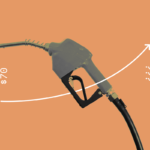(Sponsor Content)
We don’t just use it to drive. It’s in the roads we drive on. In fact, it is used in over 6,000 products that help make up modern life. “Oil,that is. Black gold. Texas tea …” And for a fossil fuel commodity supposedly going the way of the dinosaur, oil is looking pretty slick these days.
Oil hit $73 recently and then moderated down to a sweet spot in the mid-$60 range. But can $100 oil really be on its way down the pipeline? Spoiler alert: you might not be thinking big enough. $100 is just a number, not a cap.
As an example of the importance of oil to the Canadian scene, let’s look at the Horizons S&P/TSX 60 Index ETF, which holds the top 60 companies on the S&P 500 index as well as the Toronto Stock Exchange. (WealthBar holds HXT because it is an efficient way to have exposure to Canadian companies or businesses in our clients’ portfolios.) A significant number of those companies are energy producers (ie. oil companies). Indeed, on the TSX, nearly one fifth of the stocks represent energy companies.
Their success fuelled a bounce to a record high in late June. Oil is back — and that means Canadian investors (or at the very least, investors in Canada’s oil-fuelled economy), a steady pipeline of profits is bubbling up.
The recent history of oil. Before the boom, the bust
If you filled up your car recently, the dog days of oil might seem like a distant memory. But it wasn’t that long ago. Thanks to a glut of supply on the world market, oil was down at $30/barrel in 2016. How did it get so low? Mostly, fracking.
North American energy companies employed new technology techniques to bump up energy production by exploiting fields formerly deemed uneconomical. This reduced the need for importing oil from abroad.
The world did not adjust, at least not right away. Russia and the OPEC countries are addicted to revenues from exported oil. With few alternatives as a revenue pipeline, these nations had continued to pump oil even as the price was clearly sliding. Soon, the world had an ocean of cheap oil on its hands.
Moving forward to the dog days of August 2017 and that glut was still choking down the price per barrel. Note the final bolded conclusion in this Bloomberg article:
When OPEC and Russia first embarked on their strategy to clear a global oil glut, it was expected to succeed within six months. It now looks like the battle could last for years.
The Organization of Petroleum Exporting Countries and its partners plan to wrap up their production cuts next spring, already nine months later than originally expected. Yet oil prices are faltering again as data from the International Energy Agency show world inventories could remain oversupplied even after the end of 2018. ESAI Energy LLC predicts that, rather than months, draining the surplus may take years.
With oil priced so low, North American energy companies struggled to keep pumping. At the height of the crash, tens of thousands of Canadians, mostly in Alberta, lost high-paying jobs. By 2017, our Prime Minister was even talking about phasing out the oil sands.
But predictions of oil’s demise were premature.
Oil slides back from the brink
The rebound in oil happened a lot quicker than the experts expected. Today, it is welling up past $70/barrel. What happened? Supply met demand.
Finally, after many false starts, in May 2017, OPEC and Russian producers agreed to cut production. At the time, commentators were pessimistic that it would have an effect in the long term (one factor: an agreement is one thing, but it’s quite another for these countries to go ahead with their pledges). But right on time, in the early months of 2018, those bloated reserves were finally depleted. The price of oil has spiked 50 per cent in the past year.
The change didn’t all happen on the supply side, of course. The economy has been doing well lately and the good times look like they will keep flowing: “A strong world economy is expected to underpin solid increases in oil demand. The International Monetary Fund sees global economic growth at 3.9% in the early part of our forecast period with all regions expected to perform well.”
As oil gushes ahead, investors are coming along for the ride
The result? Nearly-busted energy companies are booming once again. Energy stocks are up. As a result, the stock market as a whole is enjoying some better performance.
And it’s not over, yet. The USA is looking to put sanctions on Iran again now that Donald Trump has canceled the nuclear deal negotiated by Barrack Obama. Oil surged to its highest level in three and a half years in the wake of the announcement. If Iran’s 2.6 million barrels of production per day are simply taken out of the equation, then $100-plus oil becomes not just a likelihood, but almost a certainty. That said, for now, the rise for oil seems to be helping more than it is hurting.
What’s coming down the pipeline for Canada’s petro-economy?
Whatever happens, oil will continue to be a big part of the picture for Canadian investors especially. As we noted in our recent Market Update:
For Canadians with lingering memories of an energy sector powering the economy (and more recently, low prices crashing the party), these swings in price can only have added to already-high stakes. The leading Liberal party switched their position from “TheTrans Mountain Pipeline Extension Will Be Built” to a somewhat more controversial “TheTrans-Mountain Pipeline Extension Will Be Built with Taxpayer Dollars.” If the federal government does actually acquire the pipeline, does this create a bigger risk for Canadians in terms of a budget that is already overstretched with high debt and an $18.1 billion deficit?
In this context, the Canadian government may have wanted to show there was more on tap from the north’s export pipeline than just maple syrup.
 Neville Joanes is the Chief Investment Officer of WealthBar, a robo-adviser. WealthBar provides unlimited financial planning with lower-fee ETF portfolios and actively managed Private Investment Portfolios. Through their financial advisers, easy-to-use online dashboard and financial tools, they make investing more accessible to all Canadians. This blog is a condensed version of a longer blog that originally ran on the WealthBar website on July 5th, here.
Neville Joanes is the Chief Investment Officer of WealthBar, a robo-adviser. WealthBar provides unlimited financial planning with lower-fee ETF portfolios and actively managed Private Investment Portfolios. Through their financial advisers, easy-to-use online dashboard and financial tools, they make investing more accessible to all Canadians. This blog is a condensed version of a longer blog that originally ran on the WealthBar website on July 5th, here.


